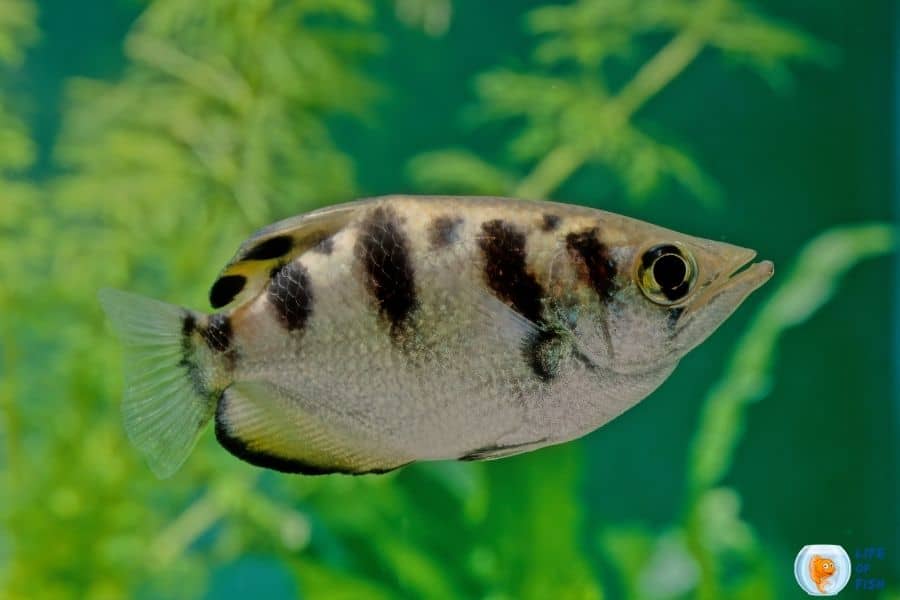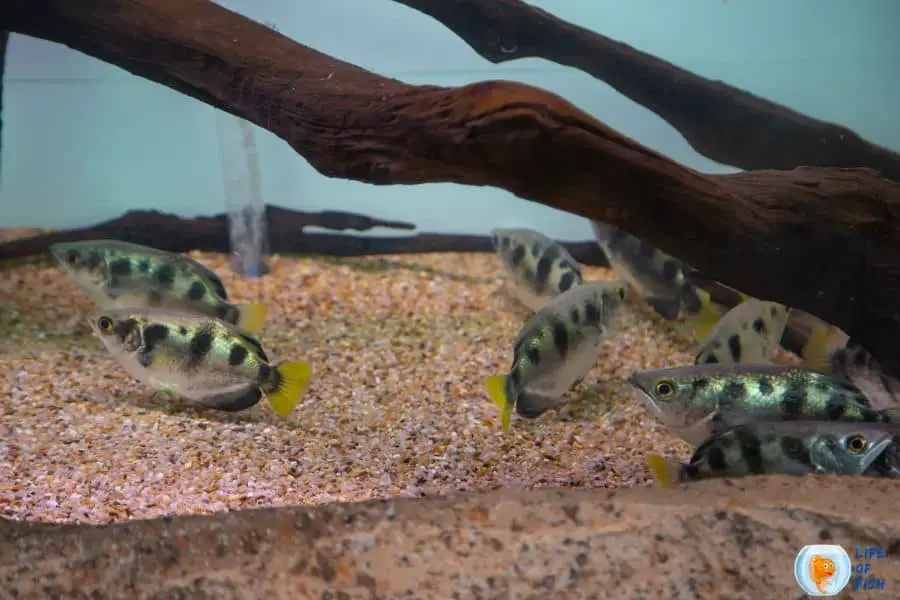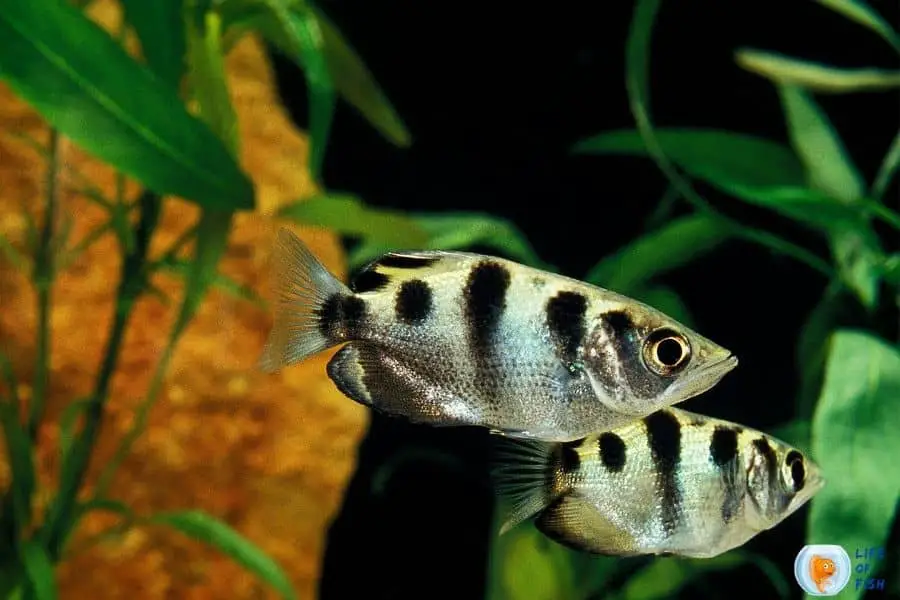Archer fish may seem like a common type of fish, but they are known for their unique ability in hunting. They have their own beauty and grow up to a whopping 12 inches long.
Archerfish are not your usual aquarium fish like Goldfish, mollies, betta fish, and carps, so their care needs in the aquarium are different from those of other fishes.
This is an Archerfish care guide written for beginner/ intermediate aquarists so they can keep these interesting fishes in their incredible aquarium.

What is Archer Fish?
Jump To
- 1 What is Archer Fish?
- 2 What is special about the archerfish?
- 3 Archerfish Appearance
- 4 How big do Archer Fish get?
- 5 Is Archer Fish aggressive?
- 6 Archer Fish behavior
- 7 How long does Archer Fish live?
- 8 One look Care guide
- 9 Archer Fish care
- 10 Archer Fish breeding
- 11 How to feed Archer Fish?
- 12 Special tips
- 13 What fish can live with Archer Fish?
- 14 Archer Fish diseases
- 15 Related Questions
- 16 Conclusion
Archer fish is a family of 10 species (Toxotidae) that live in both freshwaters and brackish waters.
Archerfish get their name from their ability to shoot water from their mouths at a target above the surface of the water.
Most archerfish species live in freshwater habitats, including rivers, streams, and pools. A few species are euryhaline, which means that they can live in both freshwater and brackish waters.
The natural habitats for Archer fish vary from clear streams and rivers to ponds, canals, and lakes.
They are generally found in the lowlands of tropical countries like India, Sri Lanka, Bangladesh, and Southeast Asia. They also live in Nothern Australia and Melanesia.
Among all 10 Archer fish species, only two species are seen in the Aquarium trade.
- Toxotes jaculatrix (banded archer)
- Toxotes chatareus (common, seven-spot, largescale archer)
The main difference between these two archer species is that the Toxotes chatareus has seven spots or bands on their bodies while the Toxotes jaculatrix has only 5.
Toxotes jaculatrix is also smaller and peaceful than its cousin.
Both species live in brackish waters. Therefore, we have to provide brackish water conditions in our aquarium for these species.
What is special about the archerfish?
Archerfish are known for their ability to shoot water from their mouths at a target above the water’s surface.
They do this by dilating and contracting their gill covers, which are controlled by a special lateral line organ. The archerfish may also move its tail back and forth to aim itself after its target.
In addition, Archerfish have very sharp eyesight, which is a factor for their ability to shoot the water with great accuracy.
They have around 3.5 cycles per degree of visual acuity, allowing them to see the distances to their target, while much other fish have less than 1 to 2 cycles per degree.
Interestingly a submarine used in world war II was named after this fish and the name of the submarine was USS Archerfish.
Archerfish Appearance
All archerfish species have a deep, laterally compressed body and a small pointy mouth.
The size of the fish will vary depending on their species, but they can grow up to 12 inches long.
The body is silver-colored and has black bands on the edges of the dorsal and anal fins.
Some species may have dark spots on their body, dorsal fin, anal fins and anal fin, but these spots vary among different species of Archerfish.
How big do Archer Fish get?
The common archerfish can reach up to 16 inches in length, while the maximum size of banded Archerfish is about 12 inches.
However, both fish species have stunted body growth in captivity. Both fish species generally reach about 5 to 8 inches in captivity.
Is Archer Fish aggressive?
Yes. Archerfish are predator fish, so they will eat any small fish that can fit in their mouths.
In addition, the banded Archerfish is generally a good community fish when kept with other non-aggressive fish species.
The common Archerfish will also do well with non-aggressive tank mates as long as it can access some cover.

Archer Fish behavior
Archerfish are generally seen in small groups, and these fishes do not show any aggression among themselves, even when it comes to food.
Archerfish are usually very active, even at night. They often come to the surface of their tank for air and will dart back into cover if they feel threatened or stressed out.
They prefer living around the surface of planted areas because they get to hunt for insects (insect prey) very easily if they hide in the shadows.
As we said before, Archerfish shoots water to hunt insects from above the surface, which makes them unique above all other fish species.
How long does Archer Fish live?
Although these fish grow larger than some other aquarium fishes, they have a very short lifespan.
The average life of an Archerfish is about two years, while some types of archerfish may live up to 10 years.
One look Care guide
| Scientific name | Family Toxotidae Genus Toxotes |
| Common name | Archerfish Archer Fish Spinner fish |
| Care level | Intermediate |
| Native to | Southeast Asia Northern Australia Melanesia |
| Type | Brackish water fish |
| Color | Silver with black spots or bands |
| Tank size | 110 gallons minimum |
| Preferred temperature | 72-88 degrees Fahrenheit |
| Other water parameters | pH: 7 to 9 Salinity: 15-35 g/l Hardness: 8-19 dGH |
| Preferred salinity | 15-35 g/l |
| Size | 12 inches in the wild 5 to 8 inches in captivity |
| Life span | 2 to 10 years |
| Temperament | Peaceful with same or large-sized fish, aggressive toward small fish, and other types of archerfish |
| Recommended tank mates | Non-aggressive large community fish, Archerfish of same species |
| Preferred food | Small flying insects Larvae Smaller fishes Crustaceans |
| Feeding frequency | Voracious feeders, 2 to 3 times per day |
| breeding | Difficult in captivity |
Archer Fish care
Unlike freshwater and saltwater fish, Archerfish require specific water conditions to thrive in captivity. Therefore, their care needs are different from those of others.
Archer Fish size
Archerfish can grow up to 12 inches long in the wild, but these fishes generally reach about 5 to 8 inches in captivity.
Archer Fish tank size
Archer fish prefer to stay in small schools, and they are quite large, so you will need a large fish tank with a capacity of 110 gallons or more.
How many Archer Fish should be kept together?
You should keep about 5 to 6 Archer fish together in the same tank. But, ensure that you don’t mix up different archer species as they do not prefer living in the same environment.
Tank setup
Archerfish can survive in fresh water for a short period of time. If kept longer, it will lead to a short lifespan and even death.
The water in the tank should be salt concentrated for maximum life expectancy. Further, the tank should be at least 110 gallons and should be taller.
A height of more than 18 inches is preferable.
Unlike other freshwater tanks, you should fill up only two-third of the tank with brackish water to leave enough space for these fish to hunt from above the water surface.
Substrate
As for the substrate type, you can use either sand or gravel as the substrate. These fish do not swim on the bottom of the tank.
They are surface dwellers. So, you are free to choose any substrate you want.
Lighting
Archerfish like a dimly lit tank because that environment is optimal for hunting insects.
This fish species prefer to swim at the middle and top of the tank so, you should try to accommodate it by arranging floating plants around the surface areas of your aquarium.
Decorations
The natural habitats of archerfish consist of plants. So, you should provide some natural floating plants to create a natural and healthy habitat.
This will help them to hide when they need to hunt or when they feel threatened.
Filtration and other equipment
Water filtration is necessary for maintaining water quality and removing any harmful chemicals from the aquarium.
You should also make sure that there is enough aeration to provide the oxygen needed for survival.
Tank Lid
You may have noticed that the archerfish is very active and sometimes jumps out of your tank. So, you should have a tight-fitting cover with no spaces to avoid accidents.
Water quality condition
In the wild, Archerfish live in water temperatures ranging from 76 to 84 degrees Fahrenheit.
However, they can live in a wide temperature range of about 72-88 degrees Fahrenheit in captivity.
Juvenile Archerfish can survive in freshwater but, they will live longer and healthier in brackish water. However, adults can only survive in brackish water conditions.
This type of fish prefers a slightly acidic pH level in the range of 7-7.5, although it is able to survive even in alkaline water with a pH level of 8-9.
The salt concentration of the tank should be between 15-35 g/l. The water hardness should be around 8-19 dGH.

Archer Fish breeding
Identifying male Archerfish from females is difficult because they do not show gender dimorphism.
Therefore, breeding is impossible in the home aquaria unless you have a large enough pond to house much fish.
Archerfish usually lay up to 3000 eggs in one spawn, and eggs tend to float until they hatch after 12 hours of fertilizing.
The newly hatched fish fry is usually a few centimeters long and can live on its own right after hatching.
Fish fry starts to learn to shoot water on their own soon after they get hungry. Even the smallest juveniles can shoot about 17 inches long jet streams of water.
Fish sold at the market are either wild-caught ones or bred in large hatcheries. In captivity, they are kept at large ponds with large schools to encourage reproduction.
There was no mention of fish breeding in home aquariums in any reliable source.
In the wild environment, they swim toward coral reefs in the breeding season.
How to feed Archer Fish?
These fish species are very active predators, so they will eat any small fish that can fit in their mouths.
They usually feed on small insects, larvae, smaller fishes, and crustaceans but prefer to predate on insects over the water surface.
They often lurk beneath the surface of the water to catch insects. Surprisingly, Archerfish can hit a target of about 5 feet away with a 99% accuracy.
When it comes to feeding, it is rather demanding because these fish rather expect flying food. Therefore, training them to eat sinking food is a difficult task.
Ensure that you provide your Archer with live food as much as possible or choose to feed them with frozen brine shrimp, bloodworms, and black worms occasionally.
Other than live foods, you can supplement them with small fish, pellets, flakes, frozen and dried foods. But, be prepared to remove more excess food because Archerfish often leave these kinds of food without eating.
If possible, let them access flying insects by putting some live mosquitos, flies, crickets, cockroaches, and spiders inside the tank so that they can continue their hunting behavior in captivity.
Special tips
If your fish refuse to eat floating or sinking food, you can try hanging food on a rod so that they can jump or “shoot” at the food to eat.
Slowly make the food closer to the water surface on the next day and let them float on the water surface after a few days. Eventually, your fish will learn to eat floating food.
What fish can live with Archer Fish?
The archerfish is a peaceful species, and it can be kept with other non-aggressive large community fish.
You should not keep different types of archerfish together because they tend to demonstrate aggression toward other archerfish species.
However, finding a good larger tankmate can be challenging because most brackish water species are smaller than Archerfish.
Since they are predator fish, Archerfish will eat any smaller fish that can fit in their mouths.
Avoid keeping them with slow or long-finned fish species because they have a tendency of being fin nippers. So, the best partner for your archer fish should be a fast and short-finned fish species.
However, you can choose to keep them with any territorial brackish water fishes such as Scats, Monos, Puffers, Unicornfish, Cichlids, and other large but non-aggressive fish species.
What else could you add?
Since Archerfish prefer to live in large schools, you should add 5-12 fishes of the same species to the tank.
Archer Fish diseases
One of the most common problems in Archerfish is injury from abrasion to their snouts.
In captivity, they often get injured due to collisions with the tank walls and the owner’s hands.
In addition, this fish species can be vulnerable to any change in its environment, so try not to move them around from one tank to another.
In captivity, they are prone to catching the same diseases as other fish species, such as ich, fin rot, and ulcer disease.

Related Questions
Are Archer Fish rare?
Archerfish are quite common, but certain species are threatened by habitat destruction and pollutants in the water.
The IUCN Red List has listed five types of archerfish in the threatened species list; zebra, primitive, small scale, banded, and big scale under “stable” or “unknown” population trends.
Do archer fish spit water?
Yes. Archerfish species do spit water to attack their prey. But, it does not mean that all of them spit water.
In fact, only a few species can shoot a mouthful of water while others can spit small amounts.
Can Archer fish live in ponds?
Yes. This type of fish can live in brackish water ponds. But, since they need a large tank, you should not keep them in small-sized ponds.
An aquarium size of at least 115 gallons (435 liters) is needed for each pair of adult Archerfish.
How much does an archer fish cost?
Depending on the species and size, Archerfish will cost you anywhere from $20 to more than $100.
Is an Archer Fish a good pet?
Yes. But, it is important to know that they are quite demanding in terms of food and tank requirements.
Conclusion
Archer fish is a unique fish with a camouflaged body and the ability to spit water to capture prey.
These are very beautiful fish that you can keep in an aquarium tank. However, they are quite demanding when it comes to food and tank requirements.
So, we would recommend these fish to intermediate aquarists with some experience in keeping brackish water aquariums.
Read Next: Pomfret Fish | 25 Super Important Facts For Beginners |
